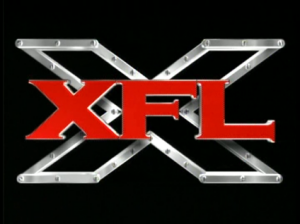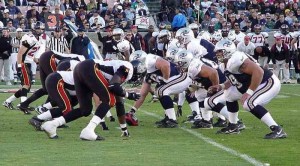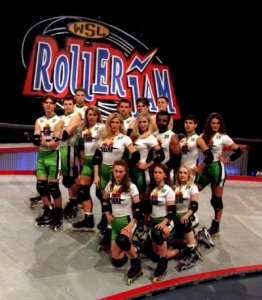Woah, my first sports related article? Well, unless you count my Athletes in Movies piece from last year and the write-ups I’ve done on professional wrestling, this is indeed the first time I’ve ever delved into straight up sports on CXF!
With the 2014 World Series in the books, basketball season just starting, and the NFL in full swing, it’s that great time of year to be a sports fan. Being a huge NBA fan, I’m hoping my hometown squad, the New York Knicks and Oklahoma City Thunder meet in the playoff finals but I’m thinking very optimistically, folks. All sports have their own farm leagues for young hopefuls to hone their skills so they can possibly get a shot at the majors later on. Some of these willing athletes will as far as journey to different variations of their key sport or help then gain attention from the public eye, building upon a new upstart company to get their big break.
Over the years, there have been several alternative sports companies that have tried to gain exposure through television with results ranging from decent to pretty disastrous. Let’s take a look:
Slamball was a pretty interesting idea that had the potential to produce a lot of great images for the ol’ highlight reel. Interestingly, the sport was actually not trying to compete with the NBA but develop its own image through creativity and crazy athleticism. Slamball was invented in the early 2000s by a gentleman named Mason Gordon who built the sport’s first court in Los Angeles from spare junk lying around him. Combining basketball with gymnastics and imagination, Slamball seemed like the next big thing. For the most part, Slamball shared the same rules as an NBA game with a few notable differences such as four players being played at a time instead of the standard five. The big difference though was that instead of continuously running up and down a court, players would jump around on trampolines in an attempt to make shots. The extra spring would make for some insane dunks and plays that would sometimes even make the big leagues turn red in the face.
The idea was intriguing enough for Spike TV to bring to their network and in 2002, Slamball starting airing. NBA legend, Shaquille O’Neal was even on hand to personally endorse the product. The sport was broadcast for two seasons before it was cancelled in 2003 after which Slamball quietly disappeared. It was resurrected a few years later in 2007 but on a much more low key level. It’s still thriving today but without any sort television exposure which is a shame. I’d love to get a game of Slamball going one day but realistically, I’ll probably just fall on my ass a lot.
For better or worse, everyone remembers the XFL. In the early 90s, World Wrestling Entertainment CEO Vince McMahon formed his own bodybuilding league called the World Bodybuilding Federation or WBF for short. After less than two years and two pay-per-view events, the league closed its doors and McMahon lost a fair bit of cash in the investment. That however, didn’t stop the billionaire from starting another sports venture less than a decade later.
In 2000, WWE announced that they were starting a football league, the Xtreme Football League. The entire sports world was talking about it. ESPN could not stop reporting it and with that kind of buzz, the wrestling-associated football league had to deliver.
With over a year to build up to the opening game, WWE would use everything in their power to hype what they thought was the next big thing. These pushes were regularly performed on wrestling television: Merchandise was pushed heavily, commentators would use football references during matches, updates on the XFL were constantly made, and the camera always cut to shots of the official XFL blimp that was floating in the sky.
Finally, opening night arrived on the NBC network and everything looked promising. Electricity was in the air and football as well as pro wrestling fans tuned in from all over the world.
The XFL mainly consisted of football faithfuls, guys who weren’t good enough to play in the NFL, and past their prime athletes who were dropped from the big dogs entirely. A few notable changes were made to the league as a way to differentiate it from the NFL and to blend elements with WWE. Cameras were taken into the locker room regularly and trash talking was encouraged. It wasn’t out of the ordinary for players and coaches to shout expletives at one another on the field. Instead of a coin toss, players had to fight for possession of the ball by being the first to sprint to the object before kickoff.
Sadly, pro wrestling’s stigma in the media’s eyes of being low-rent, entertainment for unintelligent dimwits couldn’t be shaken and as a result, the league never got respect from any outlet. After the opening game, NBC stopped airing XFL and ratings suffered. It eventually became so terrible that they hyped up a segment where they took cameras into the cheerleaders’ locker room in a desperate attempt to create more buzz. Vintage WWE.
One of the only players that anyone remembers from the league was Rod Smart who went by the nickname “He Hate Me” and that’s only because of his ridiculous moniker. He went on to play for the Philadelphia Eagles and the Carolina Panthers. Another notable player was quarterback Tommy Maddox, winner of the XFL Championship (as part of the Los Angeles Xtreme) and later a starter for the Pittsburgh Steelers.
After two excruciating months, the season was done and the XFL was no more. Vince McMahon lost millions of his fortune, something he is still mocked for to this day.
Funnily enough, an XFL player actually made his way into WWE years later as a wrestler. Richard Young, who competed as Ricky Ortiz, stepped into the squared circle in 2008. He wrestled for about a year before being dropped.
Did the XFL really deserve better? What do you think?
RollerJam was pretty odd as I don’t remember there ever being much an an audience for roller derby, especially in the late 90s/early 2000s. Spike TV (known as TNN at the time) wanted to be different from all other networks and broadcast a sensationalized version of roller derby every Friday night on their network. This was the birth of RollerJam.
Apparently, this was indeed not the first time roller derby got TV time. In 1989, the sport’s first exposure came in RollerGames, which aired for one season on television.
In 1999, the anarchist wrestling promotion, Extreme Championship Wrestling, finally secured a national TV deal airing Friday nights on TNN. ECW was used as a lead-in for RollerJam which aired right after. It was exactly what you would expect from a roller derby program. Two teams would skate around a track… and skate… and skate… and skate some more. It was incredibly boring. Similar to how pseudo-American Gladiators program, Battle Dome, would rip off elements of wrestling to spark interest and ratings, somebody got the bright idea that roller derby of all things should borrow the violence and cheesy drama from pro wrestling as well to lure in fans. Soon, RollerJam races would often include players taking physical jabs and swipes at the opposing team creating storylines between them complete with acting that would make pro wrestling look like a Scorsese film.
RollerJam was mercifully cancelled after one year and roller derby was been absent from any sort of television programming since. Thanks heavens.
In the mid-late 2000s, mixed martial arts was back in full force. It was the hottest sport around and Ultimate Fighting Champion, the sport’s premiere company, was here to stay. So many companies started popping up around the time of MMA’s resurgence including the company I’m going to talk about, EliteXC. Elite Xtreme Combat was founded in 2006 with their first event taking place in 2007. After a few reasonably successful cards, the company signed the world’s hottest fighter at the time, a big burly, Caribbean dude named Kimbo Slice.
Kimbo gained a lot of notoriety through the internet around the time he was signed to EliteXC. Videos surfaced online of many street fights with him dominating other fighters which intrigued everyone. The world wondered what he can do in the Octagon so Slice naturally became the talk of the company. After Slice became victorious in his first three fights with EXC, he fought in the main event of their 11th show, taking on Seth Petruzelli who was a replacement for his original opponent, Frank Shamrock. Petruzelli was a contestant on the second season of MMA reality show, the Ultimate Fighter but was eliminated by the show’s end. After being given the shaft by UFC, Seth had moderate success in other MMA competitions. Sensing his big break, he rose to the occasion.
The fight aired live on the CBS network which was the sport’s debut on prime time TV. Slice was KO’ed in the first round in 14 seconds. People started seeing Kimbo as a fraud and the loss pretty much bankrupted the company. Investors questioned the influence of their representatives on Petruzelli who allegedly was told to display certain tactics in the fight. The controversy resulted in the company’s invester pulling out and EliteXC headed for bankruptcy not long after never to be heard of again.
Don’t worry, Slice still beats people up for a living, though now he does it in the boxing ring.
CXF readers what are your predictions for the 2014-2015 NBA season? Who’s going to the Superbowl? Let me know by leaving a comment. Happy sporting!







One Comment
Leave a Reply